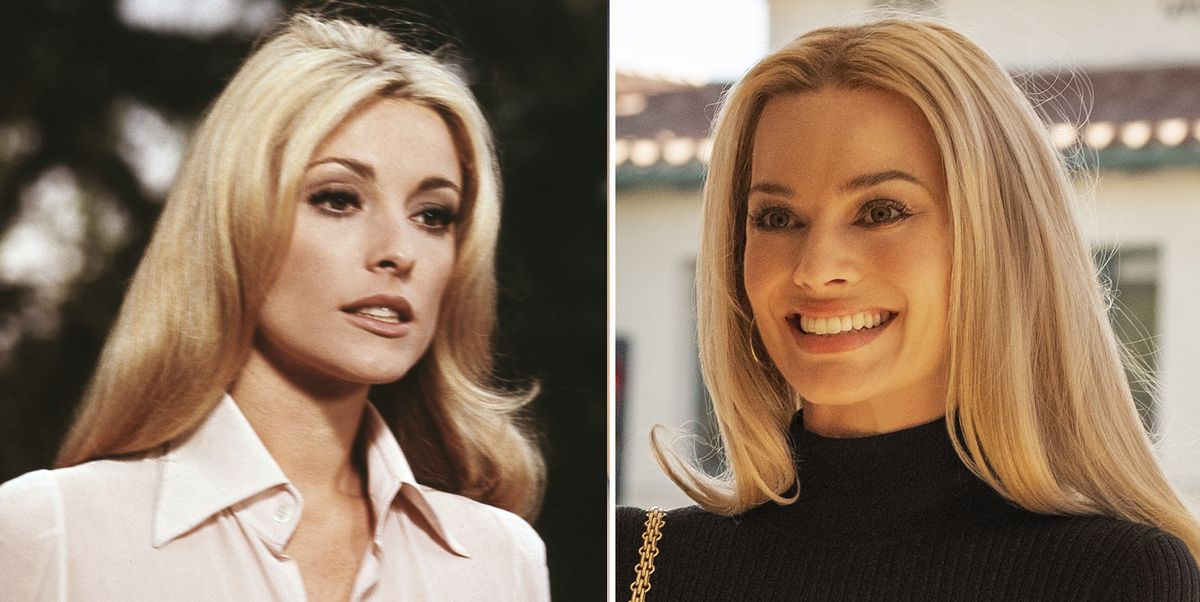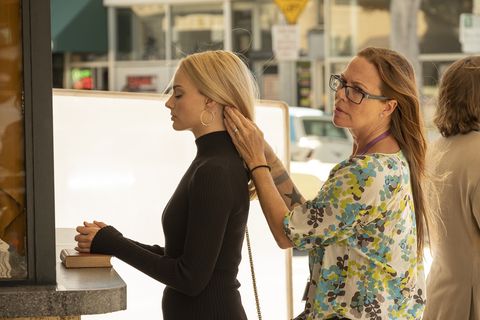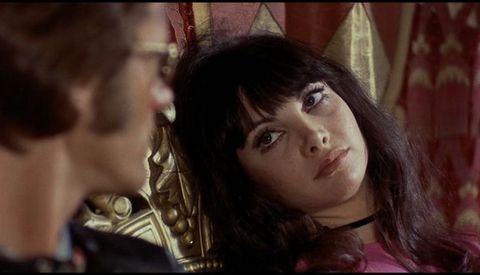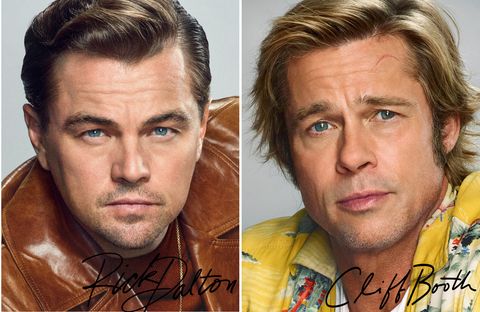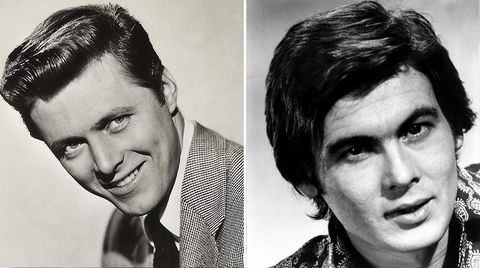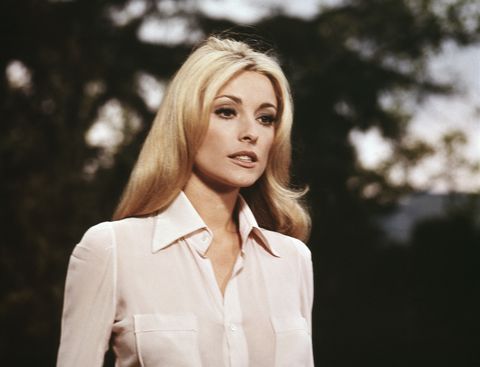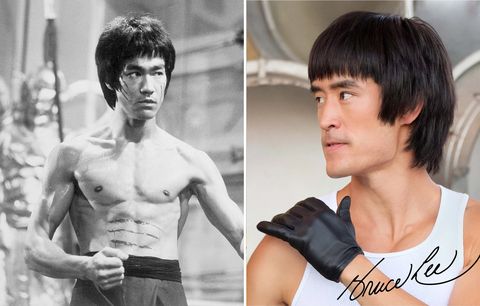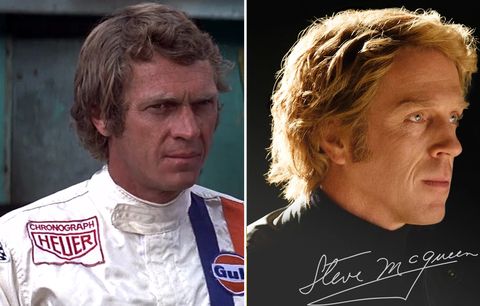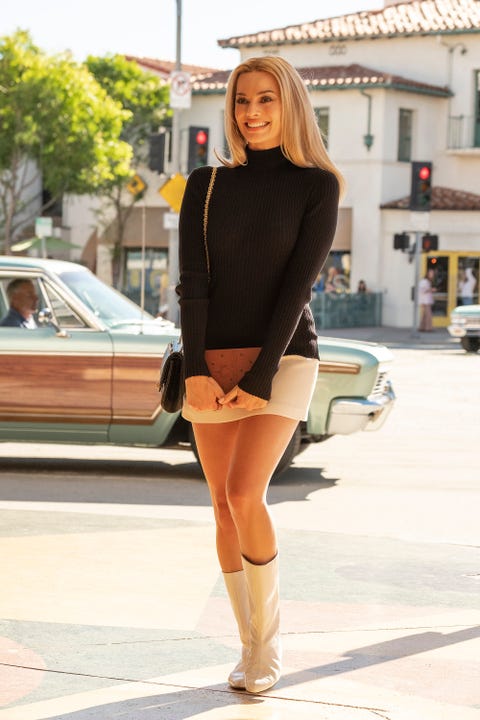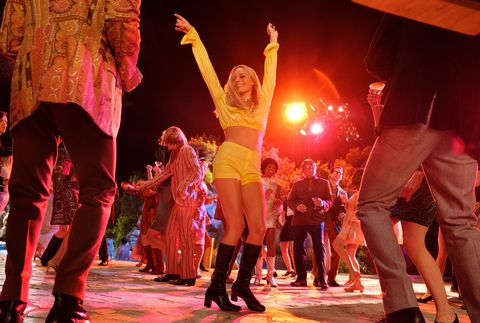Today, Quentin Tarantino’s Once Upon a Time in Hollywood debuts, placing an all-star cast—including Leonardo DiCaprio, Brad Pitt, and Margot Robbie—in 1969 Los Angeles, during the end of Hollywood’s Golden Age. The characters are a mix of fiction (DiCaprio and Pitt play a made-up fading western TV star and his stunt double, respectively) and reality (Robbie plays Sharon Tate, the model and actress murdered by the Manson Family). The film is a visual feast—thanks in large part to the period-accurate styling. The ’60s, after all, brought us some of the most iconic and enduring hair trends to date.
Hair department head Janine Thompson—an industry veteran who has worked on countless titles like the Avengers franchise, Fast & Furious, and Bridesmaids—tells ELLE.com that Tarantino had crystal clear cues for how he wanted characters to look. Both of them are Los Angeles natives, so they pulled from memory, personal references, and actual Hollywood actors to inform every hairstyle that appeared on screen.
“Most of the characters were Quentin-driven. He has such a specific idea in his head down to the T. He just knows what he wants. When you’re talking to him, you just have to be writing as fast as you can because you have to go look up who he’s talking about.” she says, adding that his inspiration was often obscure and buried deep in Hollywood history. “Quentin is a wealth of knowledge. He knows every actor’s name and movie they’ve ever done. He’s like an idiot savant about it. It’s really fascinating.”
Thompson elaborated about a time Tarantino referenced the look of Toni Basil, who is most famous for her ’80s earworm “Mickey.” She recalls,”I started looking up old pictures of her and she was in Easy Rider and was just stunningly beautiful. I remember noticing that beautiful woman—I didn’t realize that was Toni Basil! So, you can’t take anything for granted when you’re talking to Quentin. You write everything down.”
Ahead, Thompson chats exclusively with ELLE.com about the extensive research process, paying homage to real-life icons, vintage hair techniques like using orange juice cans as hair rollers, and more.
How did you approach doing research for all of the hair looks?
Speaking with Quentin, we came to the conclusion that the LA riots [the Watts riots of 1965] that happened scared the people of Los Angeles so much that they all kind of retreated back into just fantasy life of, “We’re just going to be quiet, and look pretty by the beach, and live life a little lighter, lighthearted.” When all the protests were coming up everywhere else in the country, it didn’t happen again in LA. So, the whole look of people in the Los Angeles area was a much softer, prettier, golden tan version of Hollywood and the beach and people weren’t quite as done and as polished. They weren’t going to the beauty parlor as often as they did in other cities.
We pulled from old family photos. My grandmother was a hairdresser when I was a little kid in Los Angeles, so I had all kinds of hair references from her and her work and we tried to take [inspiration] more from real-life LA city photos as opposed to looking at movies. I spoke to everybody that I could talk to in my family and friend’s families and got literally family albums and started looking at them because I wanted it to be real Los Angeles.
Surprisingly enough, we did a scene at the Playboy Mansion and the Hefner Library has unbelievable books that you can look through from mostly Playboy stuff, but there’s a lot of LA in there. So we looked through all of that. We had a full different set of books: one was for post- and pre- basically the evolution of Hollywood.
How far ahead do you have to start preparing to create the hair looks for Once Upon A Time?
I think we started in January, then started filming until August. It takes a long time! Quentin really wanted us to show the difference between old Hollywood and the new Hollywood coming into town. He wanted it to really be specific: So when we shot the Musso & Frank Grill scene, they were very polished. It was more old Hollywood. He wanted you to see this stuffier, more iconic Hollywood look of the Marilyn Monroe days. Then, he wanted to really feel it when we went outside and we saw the hippies walking down the street. He wanted you to instantly feel differently without even really realizing why you did.
What were some specific actor references you pulled for each character?
Leo and Brad we had more leeway because since they were fictional characters. We based Brad Pitt’s look off of a actor named Christopher Jones, who I had never even heard of. I went back, started looking for him all up and his movies and coincidentally, he does kind of look like Brad in the first place. So we kind of took Brad’s look based on Christopher Jones, but you know we also wanted Brad and Leo to contrast each other. So, Leo was kind of based on Edd Byrnes because he was still very Old Hollywood. Christopher Jones was clearly new Hollywood, but we wanted them to look authentic at the same time. It really mattered that Brad’s hair looked windblown because he drives around in a convertible Karmann Ghia the whole movie. Quentin really wanted it to look like his hair is always blowing in the car, constantly looking like he just got out of the Karmann Ghia. That was fun.
Other ones all over our walls were Claudia Cardinale, Julie Christie. We take all the photos and we’d put them all up all of our trailers. So, every day when we were doing hair, we’d look up and be surrounded by all this iconic work. Some of my mother’s high school senior pictures out of one of her yearbooks were all over my walls. My mother was 19 in 1969, so it was kind of perfect reference time for her.
How did you approach characters based off of real life, namely Sharon Tate?
We did not try to modernize anything [about Sharon Tate] on purpose. We tried to stay as accurate as we possibly could. We pulled up every photo we could find of her. I think between the wardrobe department and us, we probably printed almost everything that she was ever photographed in. Then, we would sit there and look at the board and go through with everybody and kind of say, “Okay, I love this look. I love that look. Which do you love?” That’s how we narrowed down.
One step, and her hair would bounce. It was sleek. It was polished. It was classic California. We were just trying to make her as Los Angeles, Hollywood, California girl as we could get her to be, you know, wholesome, beautiful, natural. For her second look as Roman Polanski’s wife it was the opposite. We wanted it to be more innocent looking. Barely-touched. Pool hair was a big thing back then. It was almost a style in Los Angeles. My grandmother worked in a beauty salon and she said, “Women would come in and want you to leave the bottoms of their hair right at their neck, out of their updo, kind of stringing and kind of down.”
They were walking out of the salon because they wanted people to know they had a pool because having a pool was a status symbol back then. So they would have them make these beautiful updos that have a mess on the bottom, which I thought was hilarious when she told me that. She said they literally would make the mess it up so that people would know that they, “Oh, I’m sorry. I just got out of the pool this afternoon.”
Sharon was always by the pool. So we gave her pool hair frequently. You know, she and I saw many photos where she had it just loosely twisted up into a knot in the back of her head, walking around her house all the time, you know? It was so hot. So we recreated that kind of soft waves that you would get from a twisted up hairstyle, just being a woman who’s hot and pregnant in the middle of Los Angeles in August.
How about other real-life characters in the film like Bruce Lee and Steve McQueen?
The Bruce Lee character, we wanted him to look just like he was from Enter the Dragon. That was not period correct. It was a different year, but [Quentin] didn’t care. He was like, “That’s the Bruce Lee everybody knows that’s what they like. That’s what I like. That’s what I want to see.” I said, “Great.” So it was kind of living a Hollywood fantasy at one point and then also being really accurate at others.
Mike Moh and I were just cracking up the whole time we were cutting it in the trailer. It was just so much fun to do because it’s a haircut you never do these days. You kind of had to remember your old Vidal Sassoon training of how to cut a perfect perimeter line and keeping the weight long. Nobody does anymore. So I think that was super fun.
Steve McQueen went through all kinds of different looks in the early ’70s and late ’60s. I pulled 15, 20 different looks off of different films and TV shows and went to show Quentin and, without a doubt in a second, he pointed right to him in the movie, Le Mans, about the race car driver and which totally surprised me because it’s actually technically not correct period wise. It’s later. And he said, “No, I absolutely want this Steve. He’s sunburned, his hair’s all dried out. He’s been driving around Hollywood in a car,” because this is when he was kind of living on the high life and partying all the time, he just loved that look. So we went with tan, slightly dried-out hair.
Did any hair styling techniques from the late ’60s get used on set?
People didn’t have blow dryers, so we tried to use as little blow dryers as possible. But, Sharon’s best friend was [hair stylist] Jay Sebring. She would go to get her hair done by Jay Sebring in the salon. She used to hang out in his salon with him all the time. That was a party place back then.
We kept her nice and bouncy and we did a few wet sets on her. There was a scene where she’s dancing around, kind of like laughing, and we wet set that on purpose because a wet set will always bounce more than a blow dry. And we knew she was going to be bouncing up and down dancing. And if you watch all the TV shows like Hullaballoo, those girls’ hair literally bounced up and down.
On a set, you can’t do a wet set every day because it takes too much time. We have to work. But it was fun because we were using huge rollers. My mother and my grandmother, they used to orange juice cans because you could pop off each end and use it as a roller. We did a lot of that.
What products did you use to achieve Margot Robbie’s gorgeous blowouts?
I always end up back with the Leonor Greyl products. I love them. I just really do. They kind of have something for everything you’re trying to create. When we were doing the bouncy styles, you put their Mousse au Lotus Volumatrice. We washed with the Shampooing au Miel shampoo. We used the Masque Fleurs de Jasmin conditioner because it wasn’t terribly heavy. We’d put all the Voluforme spray all in the roots and the mousse, and it made such a difference with the bounce. They didn’t have mousse back then. I don’t know how they did it! We used cans and cans and cans of hairspray—the Laque Souple.
Did you use any hair products on the men?
We used Leonor Greyl Lait Luminescence Biphase, Éclat Naturel Styling Cream, and the Serum de Soie Sublimateur. You could get that shine and you could get it to lay down as if it hadn’t been blow dried because boys were absolutely not blowdrying their hair. Back in the day they used VO5. So we wanted to modernize it cause that’s stuff you can’t get out of your hair.
What was the most rewarding part of working on this film?
Honestly, the homage to Los Angeles. So many times, I see films that are period and the everybody’s pulling the same reference, 1960s movies, and they look at movie hair. Well, movie hair wasn’t what people looked like and it and living here, I grew up here. I really wanted it to look different because it was different and I remembered that. This isn’t San Francisco. This isn’t New York. It’s LA. We literally made a New York and San Francisco hairstyle board saying, “Don’t do this.”
At times we had 40 hairdressers working with us. We pulled a lot of the old school hairdressers out of retirement even, to come back to work. We had one hairdresser that worked at Jay Sebring’s Salon who was with us doing hair. So, we tried to be as authentic as we possibly could and I think that was the part that was rewarding for me is to see it on the day when you say, “rolling” and 200 extras walked by you that look like the old videos my mother used to have on her camera rolls of our home movies. It made me happy.
This interview has been edited and condensed for clarity.
